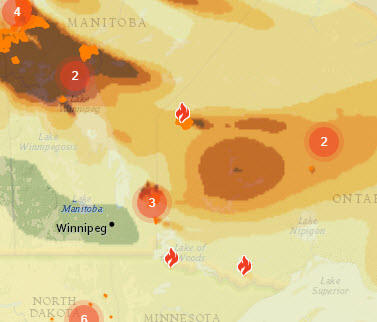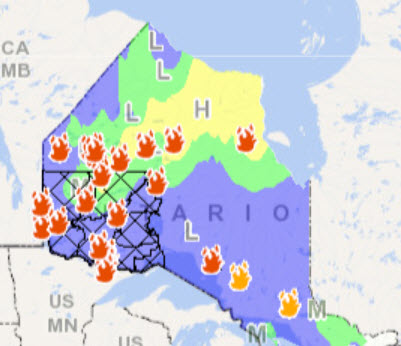In Thunder Bay District, the most common threat to air quality is wildfire smoke. The role of Thunder Bay District Health Unit (TBDHU) is to raise awareness and provide information about this health concern. This page has information on steps you can take to protect your health during wildfire season and reduce your exposure to wildfire smoke.
| CURRENT SMOKE FORECAST | FOREST FIRE MAP (MNR) |
 |
Wildfire Smoke
The smoke from wildfires contains gases and fine particles. This includes toxic gases like carbon monoxide, sulphur dioxide, and ozone. These are bad for our health, even at low levels. The mix of gases varies based on the wildfire conditions, weather, and other human emissions such as traffic-related air pollution.
Wildfire smoke can travel hundreds and even thousands of kilometers—so even when we don’t have local wildfires, we can get wildfire smoke from other parts of the province, country, and the U.S.. Air quality and visibility related to wildfire smoke can also change over short distances and from hour to hour. Because wildfires and their smoke can be hard to predict, it is good to be prepared.
Health Canada Resources
- Wildfire smoke, air quality and your health: Overview
- What is fine particulate matter?
- Preparing for wildfire smoke events
- Using an air purifier to filter wildfire smoke
- Protect your indoor air from outdoor pollutants
- Using a respirator mask during wildfire smoke events
- Wildfire smoke with extreme heat
- If you are responsible for creating or managing community-based cleaner air spaces for wildfire smoke events, find advice and a simple checklist within the Cleaner Air Spaces Guidance.
Environment and Climate Change Canada Resources
- Download the WeatherCAN app and receive free notifications about weather events, extreme heat, and special air quality statements
- Consult the air quality health index (AQHI) for your community
- Weather Alerts for Canada
